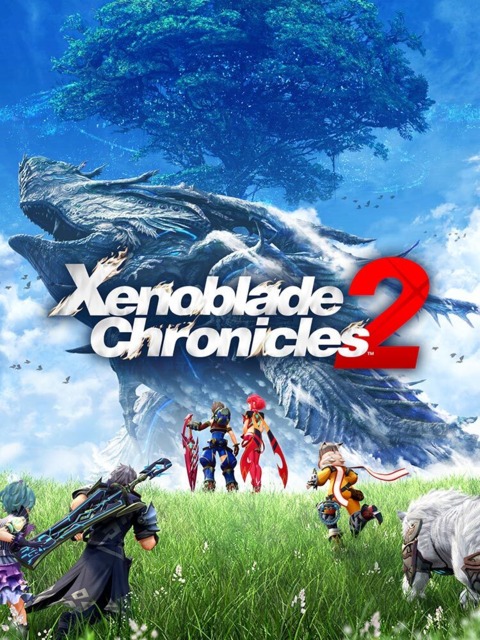An ambitious title with too many problems to count
Xenoblade Chronicles 2 is a phenomenal epic. Even when compared to its JRPG peers, the game remains triumphant in terms of world building and gameplay complexity. The game is a mix of high fantasy and sci-fi and stands out from others like its genre. There is a memorable orchestral synth-rock soundtrack that will stay with you long after you’ve finished playing for the night. The game is an absolute monster that will require hundreds of hours to complete. It is a deep, dense and challenging game, perfect for hardcore fans of the genre. Xenoblade Chronicles 2 has the bones of a great game but unfortunately suffers from numerous narrative, gameplay and technical flaws that makes it hard to recommend even to the most ardent fans of the original game.
Xenoblade Chronicles 2 is not a direct sequel to Xenoblade Chronicles but takes place in the same universe. The game can be played standalone but there are a few moments that reference the first game where the context and significance will be lost on newcomers. Players who don’t want to spend the time playing a 60+ hour game should be fine reading or watching a summary of the original game. Despite sharing the same universe, the game tonally could not be more different. Xenoblade Chronicles 2 to put it bluntly, is anime as fuck. The game lacks the subtlety of the original and everything from the dialog to the character interactions are dialed up to 11. The game manages to check every trope found in a typical Shōnen anime like over-the-top action sequences, an abhorrent amount of shouting and plenty of well-endowed anime ladies in skimpy outfits. The goofy, childish and horny presentation of the game completely overshadows the more somber moments making it hard to take the plot seriously.
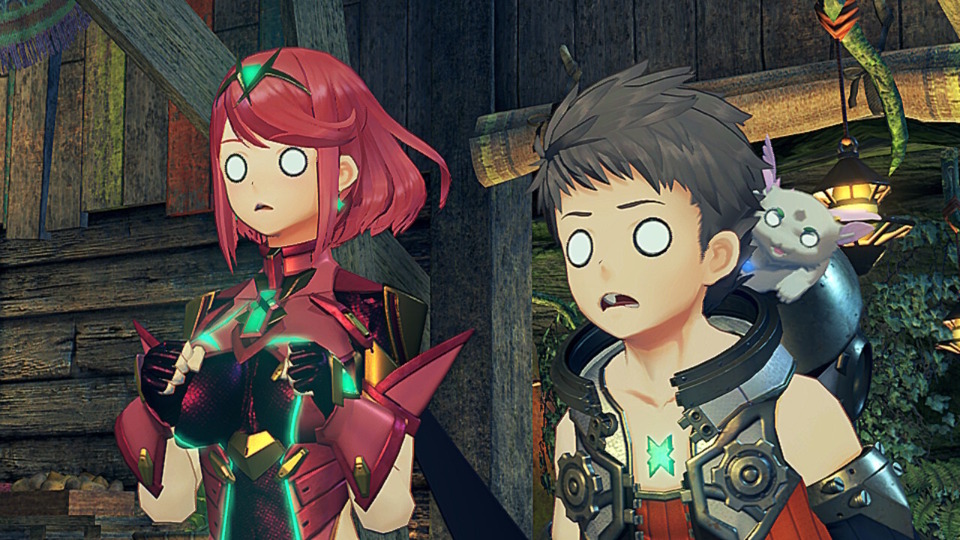
Xenoblade Chronicles 2 takes place in Alrest, a world where people live on massive titans surrounded by a sea of clouds. The main protagonist is Rex, a young salvager who makes ends meet by diving beneath the clouds to retrieve treasure. On one fateful day as Rex is turning in his loot, he is summoned by the trading guild chairman to work on a special assignment with a massive payout. Torna, the group that submitted the request, asks Rex and other fellow salvagers to look for a wreck in uncharted clouds. Rex notices that Torna consists of all Drivers. Drivers are warriors who bond with ethereal-like beings known as Blades and are highly respected individuals due to their power in battle. Rex’s dream is to become a Driver and accepts the assignment not only for the money but because he wants to learn more about being a Driver.
Rex and Torna successfully salvage the wreck only to find a mysterious woman trapped in a coffin. It turns out that the woman Torna was looking for is Pyra, also known as the Aegis; a legendary Blade considered to be the most powerful in all of Alrest. Rex unwittingly bonds with Pyra and promises to take her to Elysium. Elysium is a vast fertile land that most people believe is a fanciful fairytale. The world of Alrest has a land problem, there is only a limited amount of livable space on the titans and some people including Rex believe that Elysium is the answer. Torna, caught off guard that Rex was able to bond with Pyra despite not being a Driver, let alone bond with the Aegis herself, chases after them. Rex and Pyra successfully flee and set off on their epic journey to reach Elysium with Torna hot on their tails.
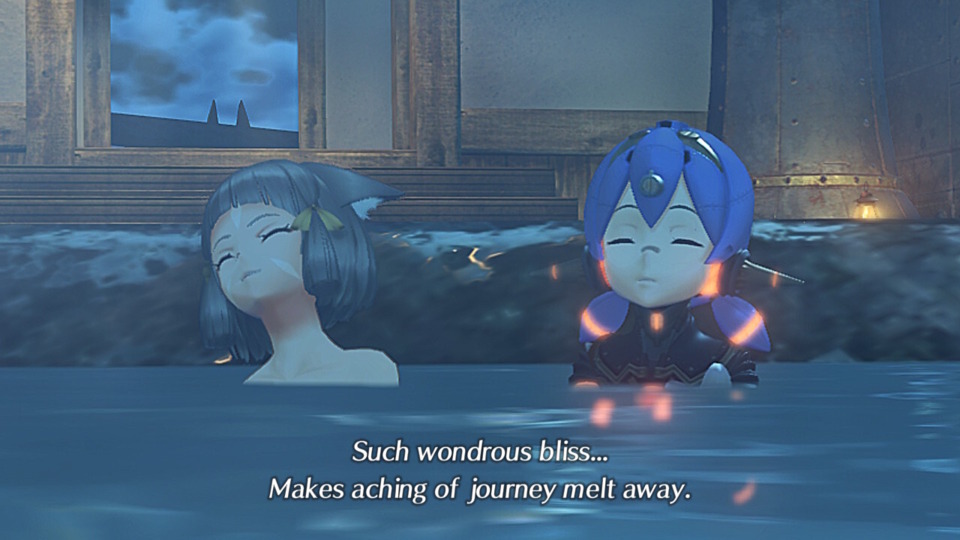
The gameplay in Xenoblade Chronicles 2 resembles that of the first game with new twists. It is an MMO-style battle system where you can see and engage foes in real-time. It uses standard RPG concepts like the classic trinity roles of Attacker, Healer and Tank. Battles can best be described as building numerous gauges to snowball into a single devastating attack. Auto attacking builds a meter to unleash Arts. Using Arts builds a meter to unleash Specials. Using three consecutive Specials in a specific elemental order within a time period unleashes an attack that seals an enemy’s ability and adds an elemental orb to the foe. And finally the elemental orbs can be broken once the Party gauge is fully charged unleashing a flurry of uninterruptible Specials. There are Arts that inflict status ailments to assist with extending the Special timer known as the Break, Topple, Launch and Smash combo system. And lastly an elemental system where some foes are weak to specific elements and change weaknesses depending on the percentage of their health.
If this sounds like a lot, it is. The game does a poor job explaining any of this. Outside of the brief text tutorials initially explaining these systems, the only other way to learn about them is to purchase one sentence hints from Informants. It is unbelievable that the game does not offer tutorials to review these mechanics. Most players will fall into a false sense of security as the game does not demand mastery of any of these systems until the end of Chapter 4, easily 30 hours into the game. I personally struggled with Chapter 4’s end boss and lost countless times only to finally figure out the “right way” to play the game through trial and error.
Rex and his friends will lose and lose a lot. Not only from the player not mastering the mechanics but in terms of the narrative. Without spoiling too much, a common motif that Xenoblade Chronicles 2 recycles are unwinnable boss fights. Even if you completely trounce the bosses in battle, our heroes will always be close to the brink of collapse until by some miracle they are able to turn the tides. Then the villains will always make their escape only to show up and fight Rex later in new more powerful forms. Recurring boss fights can be fun if the foes themselves are interesting. Unfortunately the game shoves most of their character development in the final chapters through flashbacks. There is so much wasted potential because for most of the game, these antagonists are treated as cliched mustache twirling villains.
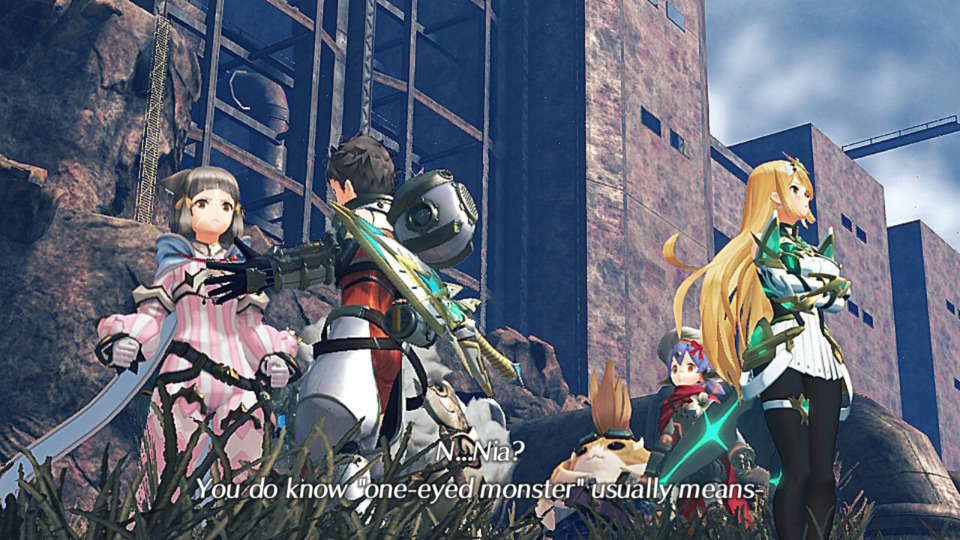
Rex will meet other Drivers along his journey eventually growing into a party of five. But other than Nia, the game barely spends time developing the other party members. Good character development is not idle chatter and watching flashbacks to learn about their backstories. Good character development is experiencing the journey of where they began, the relationships that are formed/broken and how much they transformed in the end. The other party members have their story moments, but they never truly grow. They remain siloed in their stereotypes for the entire game. Ironically, the Blades that these Drivers’ are bonded with, receive substantially more screen time and are more interesting to follow.
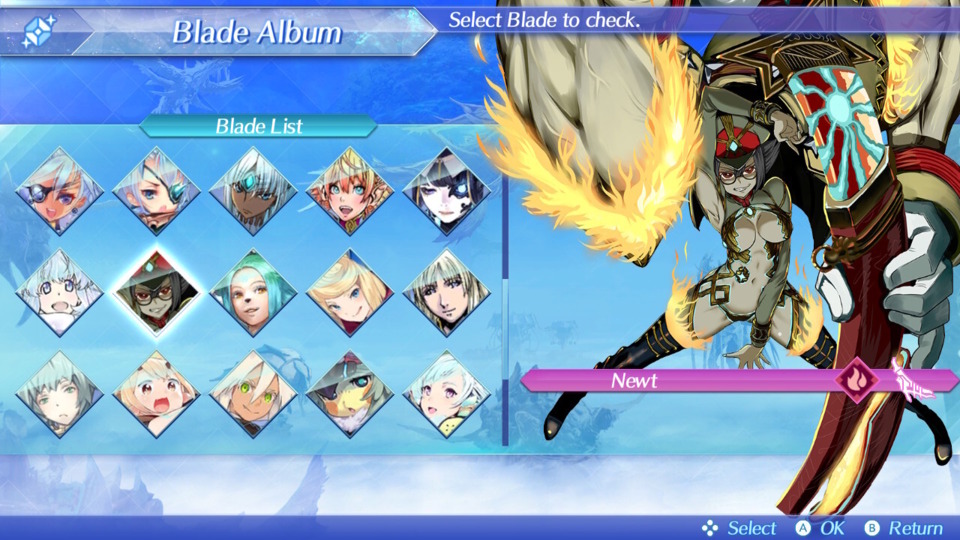
The lifecycle of Blades takes up a large chunk of the narrative. The bond between the Blades and their Drivers are permanent. Blades are immortal but their bonded Drivers are not. Once the Driver passes away, the Blade reverts back into a Core Crystal losing all of their memories. The cycle begins anew when a different Driver activates that crystal. The game turns philosophical at times and questions what it means to be alive, how important memories are and if nurture can overcome nature. Naturally the story teases situations where some Blades find ways to preserve their memories while some Drivers try to find ways to prolong their lives.
The Core Crystals are the main draw of Xenoblade Chronicles 2. Rex and his fellow Drivers are always bonded with one Blade due to the plot but can also bond with more Blades by activating Core Crystals found in the game. There are two types of Blades, Common Blades and Rare Blades. As their names suggest, Common Blades are generic looking Blades with randomized stats while Rare Blades come with unique designs, voice acting and skills. While it is completely viable to beat the game using only Common Blades, the rewards and unique side quests from the Rare Blades make them more valuable. Ascertaining these Rare Blades is a complete headache because gathering them is based on random draws.
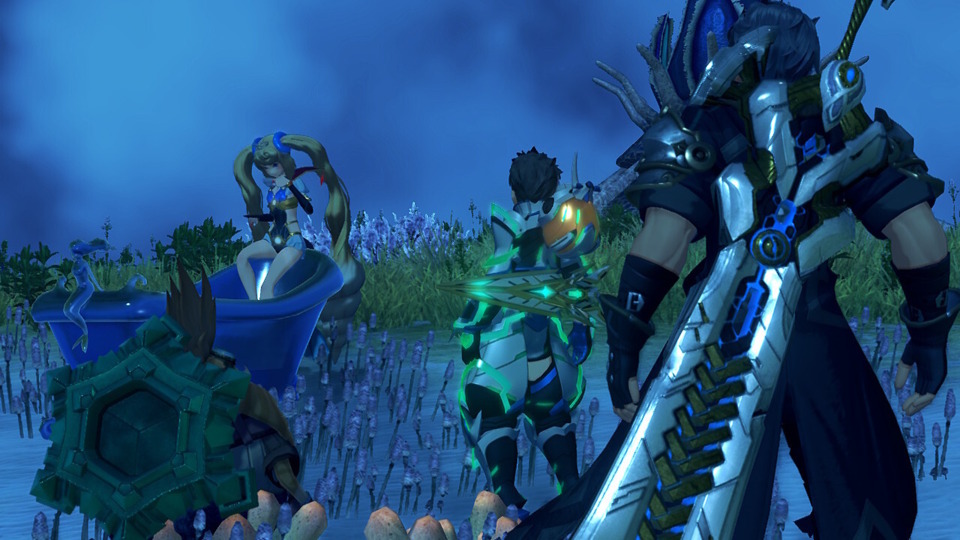
The chances of getting a Rare Blade can be improved by using Rare and Legendary Core Crystals and with a high luck stat. But even with the most optimum settings, you will often get Common Blades. While Xenoblade Chronicles 2 does not have any microtransactions, the introduction of a Gatcha-like system is completely superfluous and is only there to waste the player’s time. RNG mechanics are present in other monster collecting games like in Pokemon, but the percentages are heavily skewed against you in XC2. Completionists who want to collect every single Rare Blade will find themselves banging their heads in frustration spending countless hours grinding for and opening Core Crystals. The designers could have easily remedied the situation by allowing Legendary Core Crystals to always guarantee a Rare Blade. The game ultimately suffers for this because some of the best and funniest content in the game are in these Rare Blade side quests.
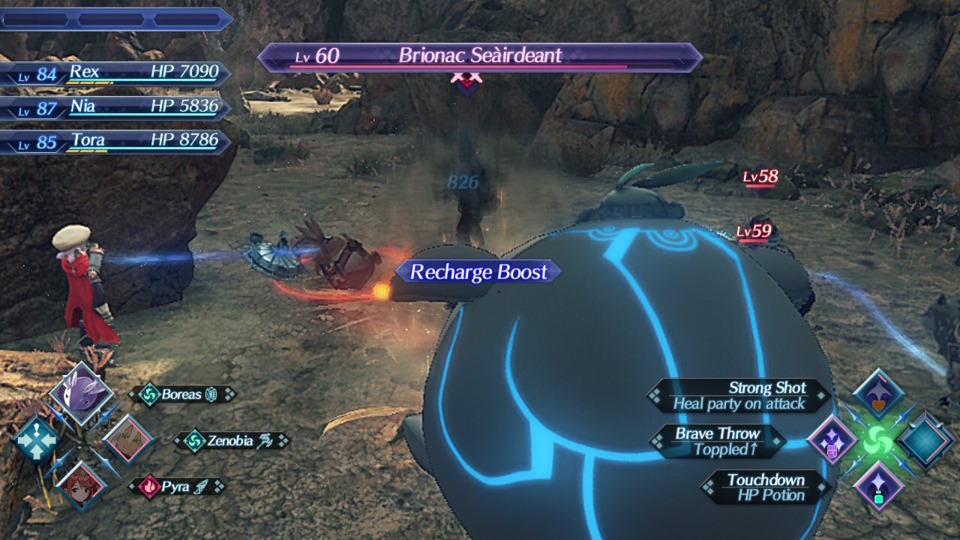
Hypothetically speaking, players could make it very far into the game without opening any Core Crystals until the last quarter of the story. Each Blade comes with a set of Field Skills that allow Rex to interact with the environment. For example, Fire Mastery will burn wooden obstacles while Lockpicking helps open treasure chests. For the majority of the game, the use of Field Skills is completely optional; they are often used for reaching a secluded area or making it easier to gather rare materials. It is only until the later chapters where the game gates progress; forcing players to have Blades with Field Skills at sufficient levels. And unsurprisingly Rare Blades have more useful Field Skills than Common Blades. Just having the right Blades is not enough, players will also need to routinely train these Blades as well as equip them when their Field Skill is needed. I did not find it any fun to constantly micromanage the party to fulfill a Field Skill check and then immediately set the party back to my preferred lineup.
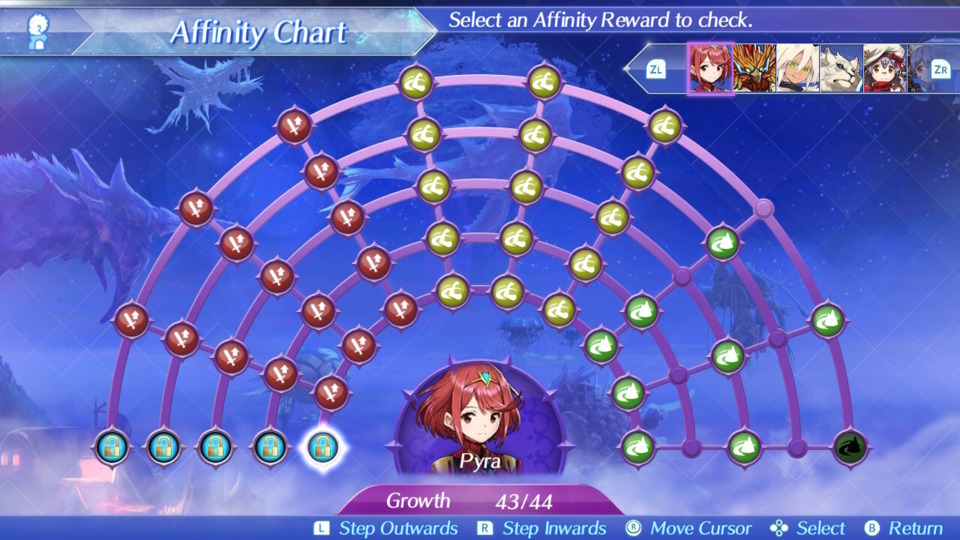
But wait! There’s more! Each Blade has their own Affinity Chart which in addition to their Field Skills contain their Combat Skills. These skills can be unlocked by meeting requirements like killing a specific enemy or collecting a specific resource. The game will routinely show pop ups once a Blade has learned a new skill, HOWEVER it will not unlock the skill until you navigate to that Blade’s Affinity Chart! That’s right folks, even if a pop up shows that Pyra learned Fire Mastery 2, players have to manually go to her Affinity Chart so that the skill actually activates. Imagine doing this routinely for every single equipped Blade! Players who choose to ignore this routine will find themselves in the late game with severely underpowered Blades and will most likely have to revisit earlier areas to unlock the skills.
Fortunately the game does provide an easy way to unlock a Blade’s Affinity Chart with the introduction of Merc Groups. About a third of the way into the game, Rex gains the ability to send Blades off to go on mercenary missions. Mercenary missions are an easy way to train inactive Blades and fill their Affinity Charts. And surprisingly, the game helps you unlock and activate the Blade’s skills automatically after they return from the missions. There are a few caveats, some skills will never unlock through these missions like those involving defeating unique monsters or requiring special tasks. In addition it is not possible to send plot critical Blades to these missions, so players will still have to routinely check on their Affinity Charts to power them up.
Tora, not to be confused with Torna, is an interesting party member because he cannot bond with a Blade. Tora instead bonds with an artificial Blade he created named Poppi. Similar to other Blades, Poppi has an Affinity Chart of her own but in addition she is customizable. Poppi is the only Blade in the game that can change classes and elemental affinities. Tora can also upgrade Poppi so that she has more Aux Cores (the equivalent of accessories) than any Blade. On paper due to her flexibility, Poppi can be one of the strongest Blades in the game. In reality, most players will never truly fulfill her potential because the ONLY way to upgrade her is to play the mini-game “Tiger! Tiger!”.
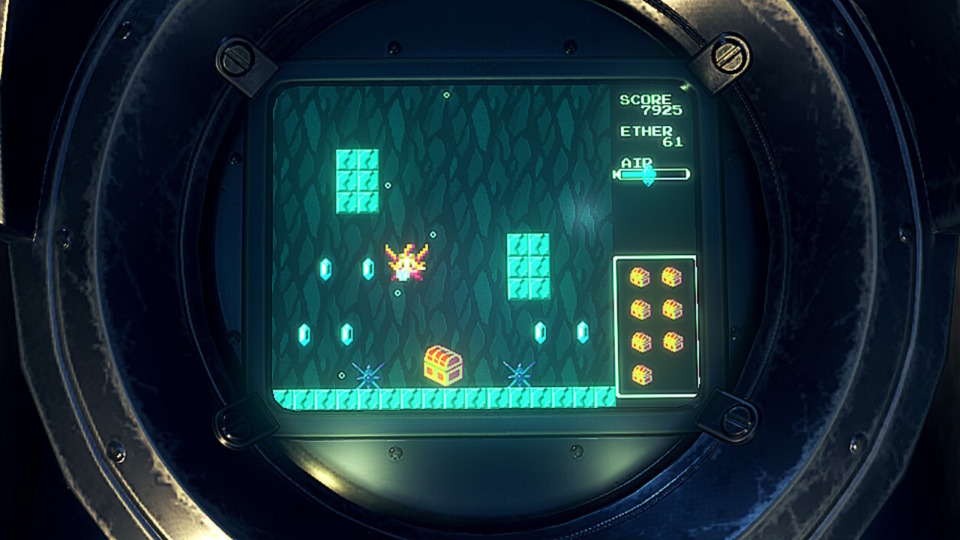
Tiger! Tiger! is an 8-bit 2D style mini-game where you guide Tora down a level collecting gems and treasure. Along the descent, there are several monsters that can attack Tora which he can defeat using a grappling hook. Once Tora reaches the bottom of the level, he collects a giant treasure chest and then ascends back to the surface. On face value, Tiger! Tiger! is a mini-game well suited for the Switch’s portable play. The problem is that the rewards are meager even if you get a Perfect Medal. More often than not, you will get partial rewards in Tiger! Tiger! and have to play about a dozen matches to accrue enough Ether Crystals to sufficiently upgrade Poppi’s abilities. Playing Tiger! Tiger! is a double-edged sword because the time spent playing the mini-game only benefits Poppi while that same amount of time could have been spent in combat or completing quests which benefits every other equipped Blade. Another issue is that you can only play this mini-game in Tora’s house, so anytime there is a need to upgrade Poppi, it’s an annoying process of Quick Traveling back and forth.
The concept of Quick Travel is not unique to Xenoblade Chronicles 2. The problem with XC2’s Quick Travel system is that it completely breaks the narrative. In Chapter 2, Rex rescues Nia from a prison aboard a capital ship. The objective at this point is to escape the ship by running towards the objective marker. However players can simply Quick Travel to a location outside of the ship and walk around freely despite the circumstances. It makes no narrative sense why this is possible. Another example would be how Rex can freely Quick Travel to the Argentum Trade Guild, which is a titan floating in the middle of Alrest, at any time, despite not having a mode of transportation to do so. This ludonarrative dissonance is everywhere in Xenoblade Chronicles 2 and not just with regards to Quick Travel. Also in Chapter 2, Tora provides a disguise for Pyra since she is essentially the most wanted Blade in all of Alrest. But at the end of Chapter 2 she does away with the disguise for some reason and no one questions it. In fact, after this point, you can go back to the town where Pyra was in-disguise and walk around freely. There are plenty of other examples I can think of at how ridiculously out of sync the narrative is with the game but it would venture into massive spoiler territory.
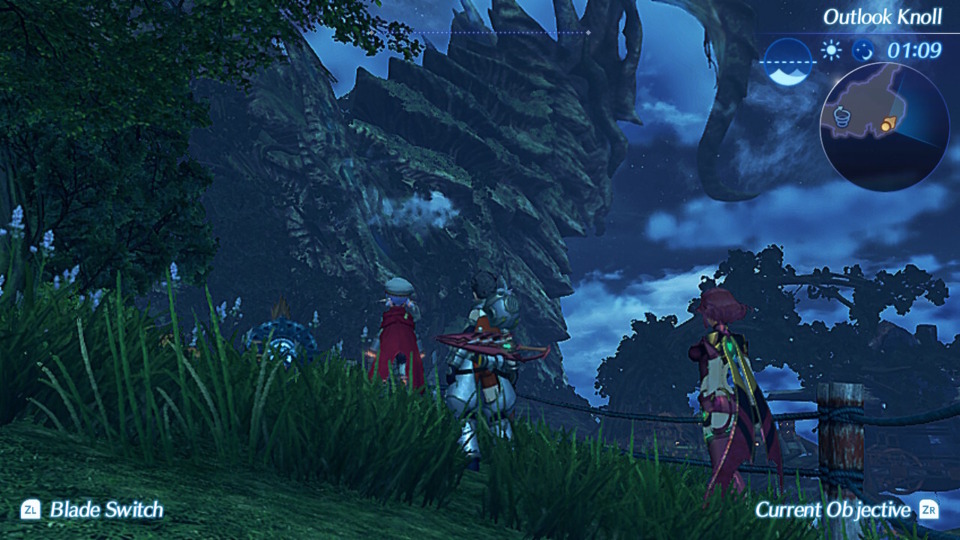
Exploring the numerous titans is genuinely impressive. Each titan sports their own unique terrain, fauna and flora. Torrigoth’s rolling green hills are teeming with life and activity. Uraya’s watery land is full of hidden diving spots. Mor Ardain’s mix of desert and heavy industry serves as a distinct contrast from the other titans. It also helps that there is a stunning soundtrack that accompanies each titan and varies depending on the time of day. Xenoblade Chronicles 2 nails the open world design, every parcel of land serves a purpose and the game rewards you for going off the beaten path with a hidden chest or an optional boss. In addition, different areas are accessible depending on whether the clouds are at low tide or high tide.
If there are problems with exploring the titans, it is that they are difficult to navigate. Torrigoth in particular has a lot of hidden vertical routes. The navigation marker is absolutely horrid because it does not leave a breadcrumb trail of how to get to the objective marker. The marker simply points to how far you are and whether you are above or below it. It is easy to get lost for hours wandering around trying to get to the next objective. In other open world games, they often use high level enemies to subtly warn players that they are going in the wrong direction. The problem is that Xenoblade Chronicles 2 teaches you the exact opposite!
There is an early quest that requires Rex to venture into an area with enemies that are significantly higher in level. Fortunately these enemies are passive and won’t attack unless provoked, but it teaches players the wrong lesson that it is okay to venture in areas that look prohibitively dangerous. Ironically the game also seems to discourage exploration at the same time by having roaming high level bosses on each titan. Don’t be surprised if you are in a fight with some level 5 bunnies and suddenly a level 80 giant ape stumbles in and one shots the entire party. The game does not do anything to signal which creatures are aggressive and which are passive. A consistent pattern I found with the game is that it does not grant many useful teaching moments but instead forces players to learn through trial and error or consult walkthroughs and guides.
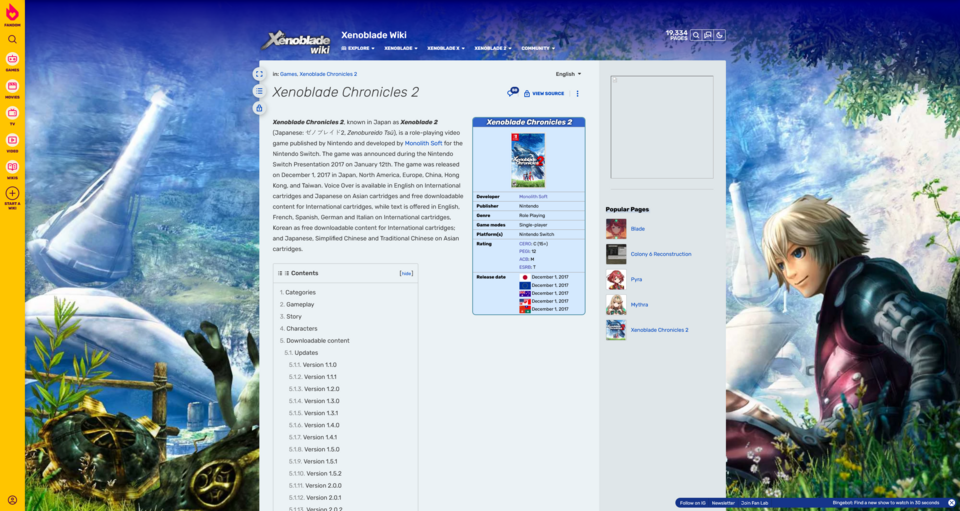
I have never relied more on guides for any game until I played Xenoblade Chronicles 2. I found myself constantly looking up information because the game fails to inform the player much of anything. The requirement to unlock Pyra’s Focus Level 2 Field Skill is to give her her favorite drink. There is no hint in the plot and no cue in the item descriptions, so you are left guessing. You could brute force your way buying every single drink in the game and gifting her one at a time or consult a guide. [I’m well aware of a Rare Blade that will tell you the main cast’s favorite foods, but unlocking him relies on Core Crystal RNG.] I had the same issue also when trying to find unique bosses. In my opinion, playing a game should not require this much outside help especially when it is to unlock a main character’s skills.
Xenoblade Chronicles 2 struggles to run well on the Switch. The game uses a dynamic resolution system to keep the frame rate stable at the cost of picture clarity. The poor performance is extremely noticeable in portable play where it can be a downright blurry mess. Typical battles are way too much for the Switch to handle. The console needs to render the three Drivers, the three Blades, the enemies and the vast terrain all in the same screen. Add-on to that the various special effects from Arts and dynamic UI elements and you have a recipe for a picture that looks like it was dumped in vaseline. Docked mode is an improvement and should be the only way to play the game. The only times I would recommend portable play is doing non-combat activities like playing the Tiger! Tiger! mini-game or unlocking dozens to hundreds of Core Crystals. Even with the Switch docked, the framerate in Xenoblade Chronicles 2 can struggle to keep up. Weather effects, especially one in Mor Ardain causes the framerate to tank. It’s a complete shame because the game is one of the best looking titles on the Switch when it is not running at sub 20 frames.
Framerate issues aside, I also encountered crashes playing the game. I spent 140 hours playing Xenoblade Chronicles 2 and experienced a total of 5 crashes. While that does not seem like a lot for the amount of time played, I have never had a game crash on the Switch except coincidentally in Xenoblade Chronicles: Definitive Edition. In that game, it only crashed once in the span of 80 hours and it was in the Future Connected epilogue. Xenoblade Chronicles 2 only auto-saves when unlocking Core Crystals so I strongly recommend saving often otherwise you may lose a lot of progress.
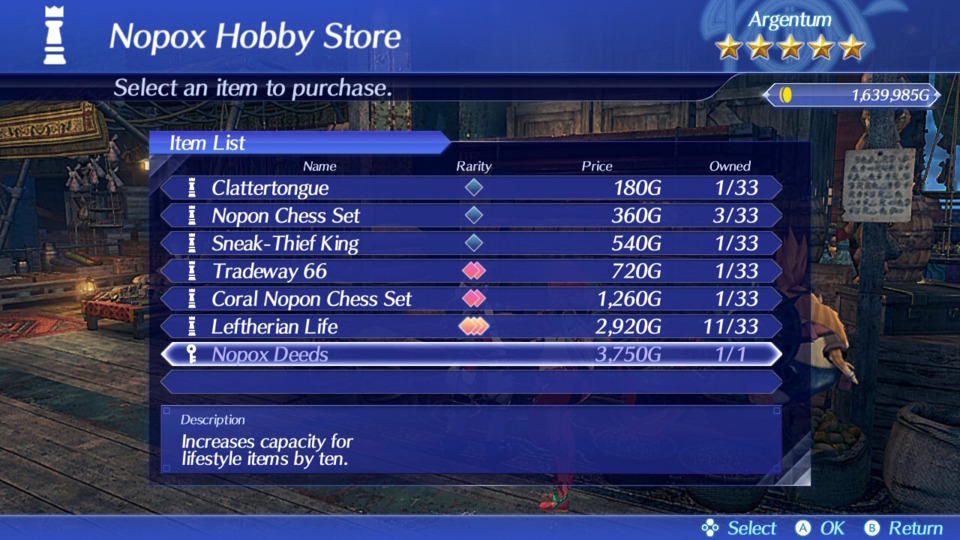
I’ve written over 20 paragraphs and still have much more to say about the game, but for the sake of my own sanity, I’m going to jot down my other thoughts on the game.
- The English voice acting is awful with lip syncing issues. I recommend to change to the Japanese vocals asap
- I did not like Rex as a character. He is like a 12 yo kid with the most powerful weapon in the world in the form of a sexy adult anime lady. He is obnoxiously brave and headstrong and such a good person to an extent that his own weakness is that he is too good of a person.
- Nopons are better portrayed in XC2 than in XC1 but still remain annoying comedic relief characters.
- Overarching narrative is strong with great twists and surprises. But the writing is bad and repetitive. Cutscenes are verbose with numerous loading screens that can extend upwards of 20 mins in the latter chapters
- One particular somber song with vocals plays in scenes that doesn’t fit the mood with what is happening. It’s the one blemish in an otherwise perfect soundtrack
- Humanoid enemies shout the same 2-3 lines in combat and can be incredibly annoying to listen to.
- The game never explains what Spike damage is and it is only used in one main boss fight.
- AI is bad and has a terrible awareness of the environment. It tends to have characters fall off cliffs and ladders and stand in toxic pools of acid. Combat is frustrating around these areas.
- Revisiting towns and having new things to do every chapter is a nice surprise.
- Sidequests are more involved than in XC1. Most come fully voiced and tasks are much less grindy.
- Being able to buy the deed to stores to gain permanent buffs is a cool concept and incentivizes players to spend money and complete side quests.
- Able to see which NPCs have something new to say is a good feature.
- Combat is skillful and not button mashy. Auto Attack canceling introduces a way to deal bonus damage and gain bonus Special charge.
- Each Blade allows you to wield different types of weapons. There are 16 types of weapons in total. It is fun to try out the different Blades to see the different weapon attack patterns and Arts. Arts differ between male and female blades of the same weapon type.
- Having Blades permanently bond to Drivers is a misstep. Often you will run into a situation where you want to have a Blade be used by another Driver. There is a valuable late game item that does transfer ownership but they are in limited quantities.
- Some Rare Blades are too large and obscure the Driver making it hard to figure out the timing to cancel Auto Attacks.
- The game should have marked the end of Chapter 6 as the point of no return (Hint: It’s down a long empty hallway). There is so much narrative momentum afterwards that it doesn’t feel right to do sidequests after this juncture.
- DLC Bonuses significantly improve the playability of the game
- Can reduce the hit points of enemies so you don’t have to deal with some ridiculously high HP enemies
- Can turn off enemy aggro, a life-saver especially when you just want to explore and not deal with a high level roaming enemy destroying your party (unfortunately unique bosses are still aggroed)
- Challenge Battle Mode is a great substitute to playing Tiger! Tiger! since you can earn rewards for Poppi there and strengthen your other Blades at the same time
- DLC Quests are much more varied than regular quests and supplements the lack of end game content
- Offers Rare Blades from the start and through quest lines so you’re not as incentivized to roll for Rare Blades
- Auto-Battle + Easy mode completely trivializes the game but it lets you grind to your heart’s content. Very useful especially for getting Noponstones and Flawless Noponstones in Challenge Battle mode
Xenoblade Chronicles 2 has the bones of a really good game. The problem is that everything is intentionally and maliciously tuned to keep the player hooked for extended periods. Every task takes longer than expected, whether it is fighting monsters with ridiculous health pools or powering up Poppi by playing Tiger! Tiger!. Nothing feels more like a waste of time when going through hundreds of Core Crystals only to unlock a few Rare Blades. The game lacks accessibility features. Navigation is more confusing than it should be. There are no reviewable tutorials in the game. And resorting to guides is nearly essential to unlock optional skills and to resolve quests. Xenoblade Chronicles 2 runs terribly. Playing the game in portable mode is a complete joke. And even when docked, the framerate cannot keep up in certain areas with weather effects. The main plot is hampered by horny anime tropes, an overall weak cast of villains and a disconnect between the narrative and the gameplay.
It’s strange to say, but even after all of these negatives, I did have some fun playing Xenoblade Chronicles 2. The main story beats were compelling enough to see the game to its very end. Unfortunately my total time spent playing is nowhere near proportional to the amount of fun I had. I can only recommend this game to people who enjoy games with a seemingly endless amount of things to do and have a LOT of spare time on their hands.
